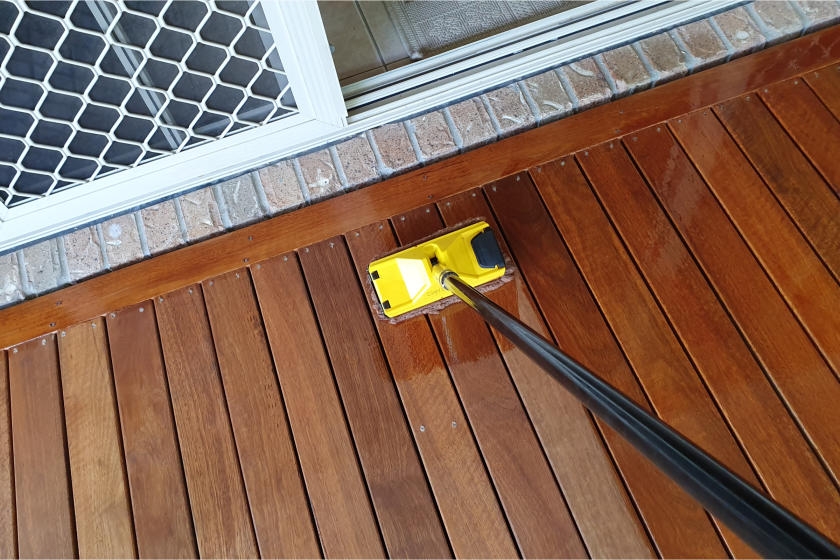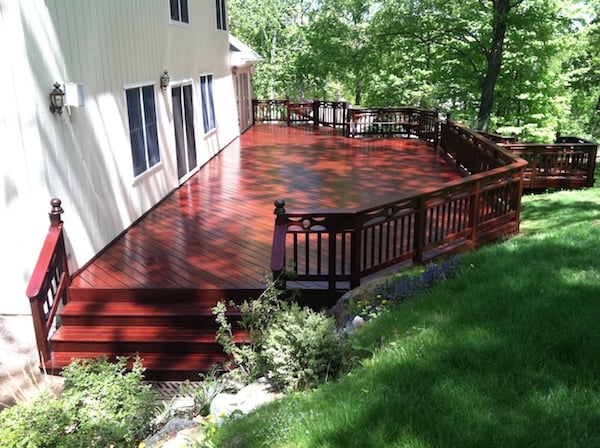Chicago Deck Staining Solutions: Expert Results Guaranteed
Chicago Deck Staining Solutions: Expert Results Guaranteed
Blog Article
A Comprehensive Overview to Various Sorts Of Deck Discoloration Techniques for Ultimate Protection and Visual Appeals
In the realm of deck upkeep, the art of discoloring stands as a critical action towards both preserving the honesty of your outside room and improving its visual allure. As we browse with the intricate globe of deck staining strategies, one begins to value the nuanced methods that can make all the distinction between an average finish and a perfect one.
Understanding Various Kinds Of Stains
Numerous kinds of stains are generally used in the process of deck staining to accomplish various visual and safety effects. On the other hand, semi-transparent stains provide an equilibrium in between shade enhancement and security, enabling some wood grain to show with.
Moreover, there are additionally specialized stains such as sealants and toners. Toners add a hint of color to the timber while providing marginal protection, making them appropriate for more recent decks with less wear. Sealers, on the other hand, offer protection against moisture and UV rays without including color, making them a prominent option for decks that already boast a desirable hue. Understanding the attributes and advantages of each kind of discolor is important for accomplishing the preferred look and resilience for your deck.
Selecting the Right Stain Shade
When thinking about the appearances of your deck discoloration job, the choice of tarnish shade plays an important role in boosting the safety high qualities of the selected tarnish type (Water-Based Stains). The color you pick can substantially influence the overall appearance of your deck, along with its capability to withstand the components over time
When selecting a tarnish color, it's necessary to think about the existing color design of your home's outside. Balancing the deck stain with the total aesthetic of your property can produce a aesthetically attractive and natural outdoor area. In addition, the color of your deck tarnish can affect the temperature of the deck surface; darker shades tend to take in even more heat, while lighter colors mirror sunshine and stay cooler.
Additionally, the kind of wood you are discoloring will certainly additionally affect exactly how the tarnish shade appears. Different timber varieties can engage with the tarnish in various methods, possibly modifying the last color. It's advisable to check the stain on a little, low-profile location of the deck to ensure the color ends up as desired before waging the entire job.
Preparing Your Deck for Discoloration
To ensure a lasting and effective deck discoloration job, thorough preparation of the deck surface is vital. Begin by cleansing the deck extensively to get rid of dust, crud, mold, and any kind of old end up or tarnish. Make use of a deck cleaner or a mixture of water and cleaning agent along with a tight brush or pressure washer to scrub the surface clean. After cleaning, permit the deck to completely dry entirely prior to carrying on to the following action.
Inspect the deck for any type of damaged or rotten boards that need to be changed. Hammer down any extending nails and sand any type of rough locations to make sure a smooth surface area for discoloration. Look for any type of loose barriers or steps that might require tightening or fixing.
When the deck is clean, completely dry, and in great fixing, think about using a wood brightener to recover the deck's natural shade and open up the timber pores for far better discolor infiltration. Lastly, shield any type of nearby plants, furnishings, or surfaces with plastic sheet prior to proceeding with the discoloration procedure. Correct preparation is crucial to attaining a professional-looking finish and making best use of the longevity of your deck discolor.
Applying Stain With Numerous Strategies
For a specialist and remarkable finish, the method of using tarnish plays a vital duty in enhancing the appearance and sturdiness of your deck. There are numerous strategies you can use to ensure an effective application of discolor.
Brushing is a standard approach that permits for accuracy and control over the amount of stain applied. It is optimal for complex locations and getting to in between deck boards (Chicago Deck Staining). Rolling is a quicker choice, covering bigger surface successfully. Nonetheless, back-brushing after rolling is advised to level the discolor and function it into the wood for better infiltration.
Splashing is one more popular technique, supplying rate and convenience of application, particularly for big deck areas. It is essential to use a top quality sprayer and be mindful of overspray. Pad applicators offer a Bonuses smooth and even end up and appropriate for both upright and horizontal surfaces. Whichever technique you pick, making sure appropriate preparation and adhering to producer guidelines will certainly help accomplish a gorgeous and long-lasting stain coating on your deck.

Maintaining and Re-staining Your Deck
When it comes to re-staining your deck, the regularity depends on different variables such as the type of tarnish utilized, the environment in your area, and exactly how much wear and tear your deck experiences. Typically, it is advised to re-stain your deck every 2-4 years to preserve its defense and aesthetic appeals.
Prior to re-staining, guarantee the deck is tidy, dry, and devoid of any previous discolor deposit. Sanding might be essential to smooth out rough areas or get rid of old discolor that is flaking. Pick a premium tarnish that suits your deck's material and gives the desired level of defense. Apply the discolor uniformly making use of the appropriate method reviewed previously in this guide to make sure a lovely and lasting finish - Water-Based Stains. By remaining proactive with upkeep and re-staining, you can appreciate a visually attractive and well-protected deck for many years to find.
Verdict
To conclude, understanding the various types of deck spots, selecting the best color, correctly preparing the deck, applying stain with numerous strategies, and re-staining the deck and preserving are necessary steps for supreme protection and official statement visual appeals. By following these steps, you can make certain that your deck stays in top condition for years ahead.
In addition, the shade of your deck stain can affect the temperature level of the deck surface; darker colors have a tendency to absorb even more warm, while lighter colors reflect sunshine and stay cooler.
It's a good idea to check the stain on a tiny, unnoticeable area of the deck to make certain the color turns out as wanted prior to proceeding with the whole job.

Report this page